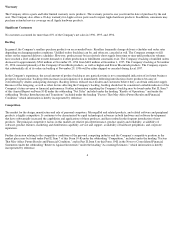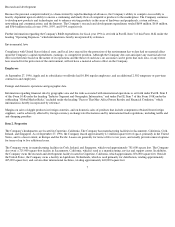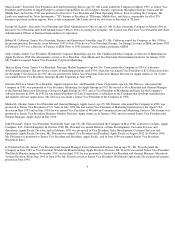Apple 1996 Annual Report Download - page 18
Download and view the complete annual report
Please find page 18 of the 1996 Apple annual report below. You can navigate through the pages in the report by either clicking on the pages listed below, or by using the keyword search tool below to find specific information within the annual report.At September 27, 1996, the Company had deferred tax assets arising from deductible temporary differences, tax losses, and tax credits of $487
million before being offset against certain deferred tax liabilities for presentation on the Company's balance sheet. A substantial portion of this
asset is realizable based on the ability to offset existing deferred tax liabilities. Realization of approximately $85 million of the asset is
dependent on the Company's ability to generate approximately $245 million of future U.S. taxable income. Management believes that it is more
likely than not that the asset will be realized based on forecasted U.S. income. However, there can be no assurance that the Company will meet
its expectations of future U.S. income. As a result, the amount of the deferred tax assets considered realizable could be reduced in the near and
long term if estimates of future taxable U.S. income are reduced. Such an occurrence could materially adversely affect the Company's financial
results and condition. The Company will continue to evaluate the realizability of the deferred tax assets quarterly by assessing the need for a
valuation allowance. For additional information regarding income taxes, refer to pages 40 - 41 of the Notes to Consolidated Financial
Statements.
Factors That May Affect Future Results and Financial Condition
The Company's future operating results and financial condition are dependent on the Company's ability to successfully develop, manufacture,
and market technologically innovative products in order to meet dynamic customer demand patterns. Inherent in this process are a number of
factors that the Company must successfully manage in order to achieve favorable future operating results and financial condition. Potential
risks and uncertainties that could affect the Company's future operating results and financial condition include, without limitation, continued
competitive pressures in the marketplace and the effect of any reaction by the Company to such competitive pressures, including pricing
actions by the Company; the ability of the Company to make timely delivery to the marketplace of successful technological innovations; the
effects of significant adverse publicity; the Company's ability to supply products in certain categories; and uncertainties concerning the
Company's ability to successfully implement its new strategic direction and restructuring actions.
The Company expects that it will not return to sustained profitability until at least the second quarter of 1997, if not later.
Restructuring of Operations
During 1996, the Company began to implement certain restructuring actions aimed at reducing its cost structure, improving its competitiveness,
and restoring sustained profitability. There are several risks inherent in the Company's efforts to transition to a new cost structure. These
include the risk that the Company will not be able to reduce expenditures quickly enough to restore sustained profitability and the risk that cost-
cutting initiatives will impair the Company's ability to innovate and remain competitive in the computer industry.
As part of its restructuring effort, the Company has begun to implement a new business model. Implementation of the new business model
involves several risks, including the risk that by simplifying its product line the Company will increase its dependence on fewer products,
potentially reduce overall sales, and increase its reliance on unproven products and technology. Another risk of the new business model is that
by increasing the proportion of the Company's products to be manufactured under outsourcing arrangements, the Company could lose control
of the quality or quantity of the products manufactured, or lose the flexibility to make timely changes in production schedules in order to
respond to changing market conditions. In addition, the new business model could adversely affect employee morale, thereby damaging the
Company's ability to retain and motivate employees. Also, because the new business model contemplates that the Company will rely to a
greater extent on collaboration and licensing arrangements with third parties, the Company will have less direct control over certain of its
research and development efforts, and its ability to create innovative new products may be reduced. Finally, even if the new business model is
successfully implemented, there can be no assurance that it will effectively resolve the various issues currently facing the Company. In
addition, although the Company believes that the actions it is taking under its restructuring plan should help restore marketplace confidence in
the Macintosh platform, there can be no assurance that such actions will be successful.
16
Provision (Benefit)
for Income Taxes 1996 Change 1995 Change 1994
Provision (benefit)
for income taxes $(479) NM $250 32% $190
Effective tax rate 37% 37% 38%
























